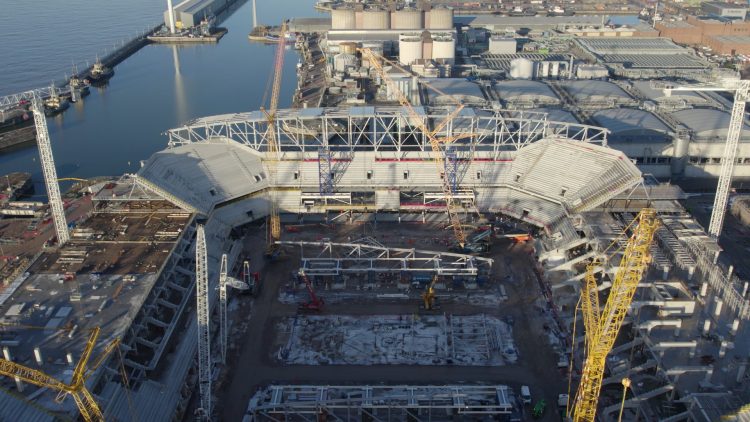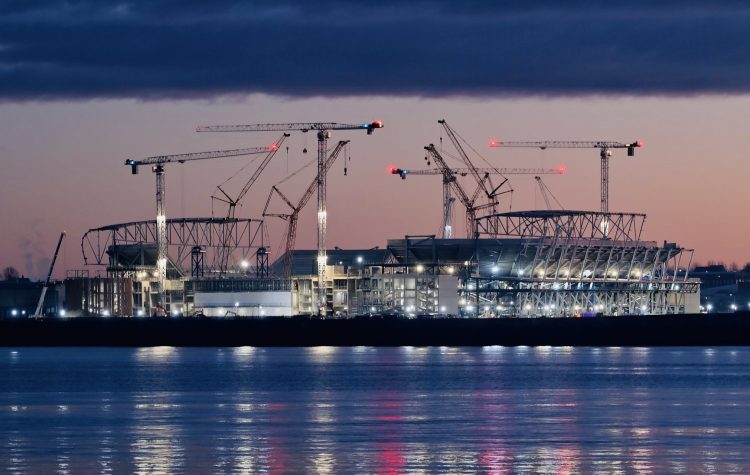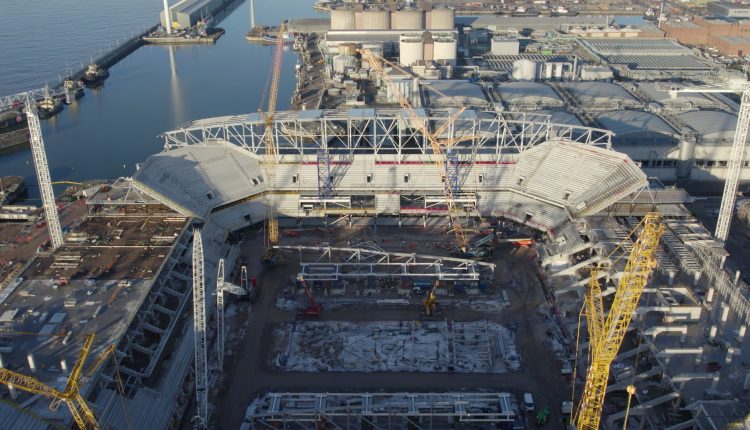Work on Everton’s £500m stadium remains on schedule thanks to a painstaking ‘just-in-time’ logistics plan that handles up to 80 deliveries a day. Tony McDonough reports

Everton FC remains on track to kick off the 2024/25 Premier League season at its new £500m stadium thanks to its ‘just-in-time’ logistics plan on the construction site.
Main contractor Laing O’Rourke started work on the project at Bramley-Moore Dock at Liverpool Waters in summer 2021. Now the shape of the 52,888-capicity arena is emerging on the Liverpool skyline.
This has happened with impressive speed and Laing O’Rourke is crediting its Design for Manufacturing and Assembly (DfMA) strategy with the progress. Figures released by the project team give an insight into the scale and complexity of the development.
Around 20,000 delivery slots for wagons were scheduled in 2022, carrying 7,300 precast concrete components, more than 6,000 steel components and 3,000 tonnes of reinforced steel from roads across the UK and Europe.
2,010 bespoke, double-stepped terracing units which will form the internal bowl lining have also crossed the Irish Sea. They were manufactured in Ireland by Laing O’Rourke’s supply chain partner, Banagher and delivered by boat to the Port of Liverpool.
During the past year, 27,613 cubic metres of in-situ concrete was delivered to site, via in excess of 3,500 mixing wagons. This was poured across all four sides of the stadium to provide the reinforced floors and ceilings.
Watch the latest video about the construction project
Add in more than a quarter of a million nuts and bolts, drainage material, aggregates and plant equipment.
“We have designed this stadium with assembly in mind, rather than construction, which is a more modern way of constructing buildings,” explained Ben Townsley, civil and structures project leader at Laing O’Rourke.
“What that means is that we have a huge number of products, materials and components that we need to bring onto the site and assemble, in order to construct the project properly.
“The term ’just-in-time’ is used across the manufacturing industry and that basically involves getting all those products to the right place at the right time.
READ MORE: Everton asks fans to ‘design your own matchday’
“With all of these different deliveries coming in through the gate, we can’t end up with a backlog and wagons queuing up down the street, annoying our neighbours, so we try to allocate a two-hour window for every delivery.
“The aim is that those components then come through the gate and, within two hours, are offloaded, installed, and the wagon leaves.
“We can have 60-80 deliveries a day and that’s the art of construction. Every component that we have to build and install has a different length of installation time. So we have to plan each delivery meticulously to attempt to make it fit within that finite window, or we would end up in chaos.”
During the past three years Ben has utilised 3D technology, allowing him ‘stand’ in a virtual stadium to visualise the detailed design of the project, which has a 150-week build schedule.

He added: “When we first started looking at this project, we sat down and decided on which days each product would come into site.
“We plan very far in advance, but you can imagine that a lot can change in the subsequent three years and we have to deal with that, all the way up to the point of installation.
“The wind may start blowing, the temperature may change and all these things can affect some of the deliveries. So we plan our deliveries meticulously as far as we can, up to two weeks in advance.
“Every very hour of the day we monitor that, moving wagons around and speaking to some of the delivery drivers to delay them, or bring them forward slightly.
“We have a huge logistics team and it’s all about teamwork. Without them pulling together and monitoring all those deliveries, we wouldn’t be where we are today.”

